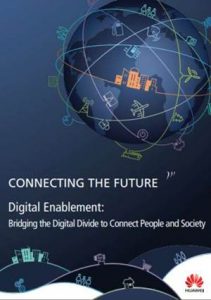My latest blog that may be of interest to some…
blog.huawei.com/2020/08/21/smart-business-models-are-needed-to-connect-schools-clinics/
Smart Business Models Are Needed to Connect Schools & Clinics
By Adam Lane
August 21, 2020
In 2015 Huawei released Connecting the Future<www.huawei.com/minisite/digital-enablement/>, a report calling on the ICT industry to develop new business models to address the digital divide.
[https://blog.huawei.com/wp-content/uploads/2020/08/Screenshot-1.jpg]
Now five years on, it is time to update this report with specific ideas that reflect today. Here I want to look at the pressing need to connect schools and clinics to the Internet and the new business models that can help do this.
It’s Not Just About Coverage
Before we look at the business models for connectivity itself, we need to acknowledge that just as the majority of the world’s population is covered by a broadband network, the majority of the world’s schools and clinics are covered too – both tend to be in population centers. The issue is not just one of connectivity infrastructure. Where infrastructure is needed, Huawei has a variety of low-cost base stations that can help.
For everywhere else with a broadband network, though, schools and clinics are not connected for similar reasons that affect much of the world’s population. These include a lack of devices (and power), suitable local content, and digital skills.
One Size Doesn’t Fit All
There are three major differences between schools and clinics that we should clarify:
* Schools often need a lot more devices and power than clinics, with a typical school needing at least one IT lab of 30 devices (usually one device per two students in a class of 60). In contrast, a clinic, depending on its size, could get by with just a few devices at crucial points of care for registering patients, consulting patients, and managing medicines.
* Educational content for schools may be quite complex with content required for multiple school years and multiple subjects, and in interactive formats for meeting local curricula. Health content is usually easier to develop through health information management systems supplemented by live consultations and training by video.
* Digital skills in schools need to start with teachers and enable them to teach digital skills to students, much like the approach that Huawei’s TECH4ALL DigiTruck program is taking in Kenya<blog.huawei.com/2020/04/30/computer-for-schools-kenya-leaving-no-one-behind-with-digitruck/>, which has so far taught digital skills to 1,145 students and 100 teachers. In clinics, it is only necessary to teach health staff, and they only need to learn to input and use health data and simple IT systems. One of the challenges in education is integrating digital skills into the educational teaching environment, which comes with additional cultural and teaching challenges.
Innovative business models can address these issues. For example, some companies subsidise devices through advertising (or e-commerce revenue obtained from consumers using those devices), while pay-as-you-go phone options sold together with solar panels (which care remotely locked if payment is not made) is now primed to take off for consumer purchases thanks to new solutions to lock smartphones and new partnerships with banks, operators, and device manufacturers.
Digital Skills Boost ROI
This year, all sorts of educational content has been rapidly created and made available either for free or affordably, with many private companies collaborating with curriculum regulators and developing different business models for governments, schools, or consumers. GSMA reports that there is now strong evidence of ROI for operators to invest in training citizens in digital skills<www.gsma.com/mobilefordevelopment/connected-society/mistt/>, since those consumers will increase their online usage and many governments have now begun increasing their investments, such as by rapidly training health staff in digital skills to collect COVID-19 related data.
Now back to connectivity, and more importantly, the affordability of connectivity. This is a critical issue, much more so than the actual connectivity infrastructure, though we can discuss that too. The challenge, as with individuals, is that business models for connectivity are usually based on recurring expenses. Connectivity can generally be provided over either fibre networks, microwave, or mobile networks. Telecommunications companies cover the up-front costs of a mobile tower, microwave tower, or fibre Internet and then recoup those costs, along with operating costs, from customers over time. In the case of a fibre connection, the up-front costs are very high, but the operating costs are very low. However, for a mobile or microwave tower, the up-front costs are less, especially on a per user basis, but the operating costs are higher, particularly power costs.
Solving the Connectivity Problem
Implementing connectivity requires either a long-term commitment to funding from schools/clinics, so that the operator makes the up-front investment, or a large up-front investment from the schools/clinics themselves, so that the operating costs are low. A key factor in deciding which option to take would be the availability of existing infrastructure. If an operator already has infrastructure (mobile, microwave, or fibre) nearby, then using that could be most cost effective, as they’ve already made much of the up-front cost and may only need minimal additional infrastructure along with the operating costs.
If there is little existing infrastructure and thus a large up-front cost is necessary, usually in fibre or microwave, the public sector could decide to make this investment itself, if there is a large amount of funding available, or a loan can be taken out and repaid over time. If the costs of that loan repayment are less than the alternative of an equivalent contract with the private sector, it could make sense. In many developing countries that lack existing infrastructure, this option is selected with the intention of renting out that infrastructure to the private sector to connect other customers nearby, and then using that revenue to recoup any loan costs. Variations on these business models are very interesting, and it can lead to interesting collaborations between the private and public sectors.
Collaboration for Connectivity
One such collaboration is with power companies. Since civil works account for a large part of fibre costs, many fibre companies co-locate their fibre on electricity poles. As schools and clinics all need electricity, one option is to connect them to fibre at the same time as connecting them to electricity grids (though some remote areas may not get connected to the grid and could use off-grid solar instead). This can reduce costs significantly. As with electricity, once it connects a school or clinic and can easily be extended to other paying customers nearby, the same can be done with broadband, and thus generate revenue. In fact, as the last mile of broadband could still be delivered wirelessly, there may be minimal costs beyond just putting Wi-Fi routers on school or clinic rooftops!
There are also innovative business models available using wireless or mobile networks. Three in particular are worth exploring:
1. When operators are given mobile licenses, they are often accompanied by various obligations for coverage (e.g. percent of population or number of base stations). But, they can also be given obligations for providing Internet to schools or clinics. Earlier this year, South Africa made additional spectrum available to operators to cope with demand during COVID-19, with one requirement being to make connectivity available to 104 district virtual classroom platforms with minimum speeds of 10 Mbps. They also mandated zero-rating (i.e. free access for mobile subscribers) to local education websites.
2. Many governments around the world have Universal Service Funds (USF) to support building base stations in rural areas. In Kenya, the current USF is requiring operators that build those base stations to connect at least one primary or secondary school in the site vicinity with a minimum speed of 10 Mbps through 1 (or more) CPEs – a CPE is a mobile router with a sim card inside that provides a Wi-Fi hotspot.
3. When operators build a base station they need land and power, among other things. Schools often have a lot of land and are secure. Many are also connected to the grid or have solar power. Kenya, for example, aims to connect all schools to power. Around the world there are mobile operators who will pay rent to a school to use their site, so it is possible for agreements to be reached whereby the operators could instead provide internet to the school in lieu of payment, as well as sharing costs on power (or even paying the school for power).
These three business models are interesting for mobile operators for two reasons:
* Operators want to increase demand for Internet usage, especially in areas where demand may be low, bringing Internet connectivity for the first time. Providing free Internet at a school will help increase demand, and those using it at school will also increase their digital skills. Students and teachers will get used to the Internet and be keen to use it more outside of school.
* Operators have a fixed capacity at a mobile site based on the equipment they are using, and much of the time this capacity is not being used. There is little marginal cost for a base station at full capacity or half capacity, other than some extra power or extra international bandwidth fees. This is one reason why many operators offer very cheap Internet packages at certain times, like night owl packages to be used (for downloading) between midnight and 5 am. Therefore, operators do not incur particularly high costs when providing schools or clinics with unused capacity.
As teachers and students become more used to online learning during COVID-19, they are not only acquiring the digital skills they need, they are also experiencing how useful online learning can be. This changes both what is possible and students’ expectations once they return to school.
The same is true in the health space. With health workers becoming accustomed to collecting health data and receiving training on COVID-19 and other diseases online, and with patients around the world becoming used to speaking to a doctor online, both health workers and patients have gained digital skills and the expectation of more online health interactions.
This is a wonderful opportunity for speeding up school and clinic connectivity efforts. And though the benefits are now clearer than ever, we know there is less money than ever, especially in developing countries.
So, let’s work together to further explore how innovative business models can help get those schools and clinics online as fast as we can.
_______________________________________________
kictanet mailing list





